A Chat with Bubsy’s Michael Berlyn – Part 1: The Rise and Fall of Bubsy
Michael Berlyn is a man of many talents — he’s an accomplished novelist, musician, game designer, and more — but he’s probably most notable, at least in the gaming world, for being the creator of Bubsy. I had the chance to chat with Mr. Berlyn on Skype for almost an hour as he was putting the final touches on his latest gaming project Ogg. (You can see more of his work at the Flexible Tales website). He walked me through the world of game development in the 1990s, the heartbreak of watching the Bubsy franchise crumble, and some of the work he’s been doing since returning to the industry more recently.
Read on for the full interview:
Josh: Bubsy was a game I really loved as a kid — I mean, I was a kid in the 90s — and I loved it. It was a fun platformer with a lot of charm. I was kind of surprised to see how the reception has changed over the years. So I went back and dug through stacks of old video game magazines, and Bubsy was getting a lot of good reviews, a lot of positive coverage. People really loved it in the 90s.
Michael Berlyn: What happened was that I created Bubsy for a company, Accolade, and I didn’t own it. I didn’t own the rights to the character or anything else; it was all Accolade’s property. I left Accolade after the first Bubsy, and they decided to do a follow-up, which was not very good and really hurt the reputation of the character and the franchise.
Josh: Absolutely. I saw some preview coverage for Bubsy 3D — I think this was EGM from like ’94 or ’95 [Correction: It was GamePro Issue #89 from December of 1996] — and they were talking about how, “We loved Bubsy 1. Bubsy 2 felt like it kind of missed the mark a little bit.” [They actually used the word “lamentable.”] I think that was the general perception 20 years ago.
Michael: They were being kind when they said it missed the mark a little.
Josh: What do you think went wrong with Bubsy 2?
Michael: Bubsy 2 was a good attempt made by people who were unfortunately not really designers…
At that time in the game design business, the game designers had to be capable of doing character design, level design, populating the levels, coordinating all of the efforts, and managing the art in the team. And working in conjunction with the producer, who did basically a lot of the same things in collaboration with the designer. It’s very much changed now, but at that time in the business, designers had more responsibility and had more control over the product…
And at the time, the [Bubsy 2] designer was a designer wannabe, let’s put it that way. That’s why it kind of fell short.
Josh: That makes sense. Going back to the original, one of the things that made the game stand out in 1993 when it was new was that Bubsy talked so much. He always wisecracking, making puns. That must have been difficult to pull off technically in ’93. What were some of the limitations that you were butting up against?
Michael: One of the things I’ve always done when I’ve designed games is try to push the envelope and try to deliver more than the platform was capable of delivering. The biggest thing for Bubsy was creating his character and not having him be a clone of Sonic or Bugs Bunny or the Cheetos [Chester] Cheetah, which they wanted me to do.
Josh: Oh really? He had his own game too!
Michael: I really wanted to create a franchise, a character who was different and had a lot of character — and as a result, Accolade, which did focus on games that have character — as opposed to just another game.
For me, the biggest problem was writing all the wisecracks and doing all the death scenes.
Josh: Yeah. There’s a lot of different things that he says as he’s dying.
Michael: Yeah. That was fun.
Did you ever see in Bubsy 3, where Bubsy shows up as Snake Pliskken [from Escape from New York and Escape from L.A.]?
Josh: I haven’t played Bubsy 3, just the first two.
Michael: You’re lucky. It was not a very good game, I’m sorry to say. It was my biggest failure.
Josh: That’s an interesting situation, because the story as I hear it is that you were in development and you showed up at an expo, and they had playable Mario 64.
Michael: Yeah.
Josh: Oh man. In that era, when you didn’t have any context to put this 3D design into, and Mario comes out… that must have been crazy.
Michael: Here’s exactly what happened: It was at the Consumer Electronics Show in Las Vegas. My then partner and I flew out there to help man Accolade’s booth and demo Bubsy 3D. It looked pretty good. I mean, it was in beta. It wasn’t a final, shippable product. But it was pretty good.
And I wandered over to the Nintendo area. I wouldn’t call it a booth; it was more like a small office building.
Josh: I’ve seen their “booth” at E3. I know, it’s crazy.
Michael: I saw Mario, and I said, “That’s it. Back to the drawing board.” I went back and told my partner to go look at Mario and come back and talk to me about it, and he did. And I said, “We can’t ship this. We just can’t.” He said, “Accolade paid us a lot of money to develop it; what are we going to do?” I said, “We’re going to go back and we’re going to do the best that we can to make it as good a product as we can with the limits that we have. And that’s what we did, but it was definitely a rude awakening when I saw Mario 64.
Mr. Miyamoto… was an employee of Nintendo, so he had all of Nintendo behind him. We were independent developers who were trying to make ends meet and ship a reasonable product. So the differences show, much to my chagrin.
Josh: I’ve read some interviews where you mentioned that just seeing Bubsy 2 was so hard for you, and I can’t imagine what seeing the reaction to Bubsy 3D after that would have been like.
Michael: I thought a lot about quitting the business, and not doing anymore games after that, not because of bad reviews or how badly Bubsy 3D was received, because frankly, it did pretty good. It didn’t do great. I mean, it was no Mario 64, but it did pretty good. There were a lot of good ideas in it. And for a platformer in 3D, no one had really done one before. So I kind of took solace in the fact that, for a stab in the dark, it was pretty good.
But I took a couple years off after that to rethink things.
Josh: Bubsy 1 and 2 are currently are on Steam Greenlight. It looks like a company called Retroism has the rights to them, and they’re putting it back in the public consciousness.
Michael: Good. More power to them.
Josh: Yeah. It got not-super-great press, but it looks like there’s enough people excited about it that it’s looking pretty positive. [It passed the Greelight approval process.] I think it’s five bucks for both games.
Michael: Well, good. A lot of my friends and old producers that I knew have messaged and texted and emailed me about it, and what can I say? I have nothing to do with it. I wish I did; I wish they’d have called me and asked me to participate, but they didn’t. I don’t have any rights to it…
Are they doing Claws Encounters of the Furred Kind?
Josh: Yup. They’re doing Claws Encounters and Bubsy 2. So it’s the two 16-bit games. They’re not doing the fairy tale one either.
Michael: Good. Thank God… They got increasingly painful, especially for me.
Josh: I bet. I read something you had said about how returning to Bubsy 3D was like returning to an old friend. I can’t even imagine. To create something beloved and then see someone tear it apart like that.
Michael: They [Accolade] came to me and said, “Help help help.” I said, “You already destroyed the character.” And they said, “Ressurrect him.” So I said, “3D is all I’ll do.” Because the PlayStation was big at the time. It was hitting huge. So I thought maybe that would do it, but it didn’t.
Josh: I will say, if there’s a song that gets in my head from the 16-bit era, it’s either ToeJam & Earl or Bubsy — that title music.
Michael: ToeJam & Earl was a great game. I loved it.
In the next part of this three-part interview series, Michael Berlyn and I talk about how the casual gaming scene re-ignited his vigor for game development, as well as some of the projects he’s been working on in the meantime.

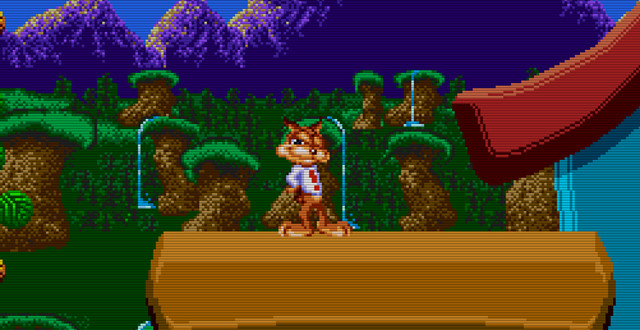
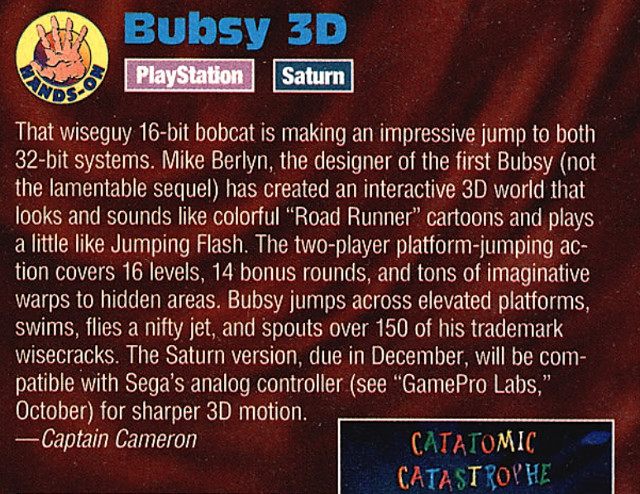
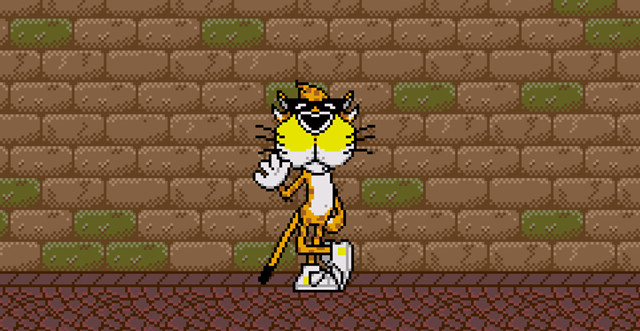
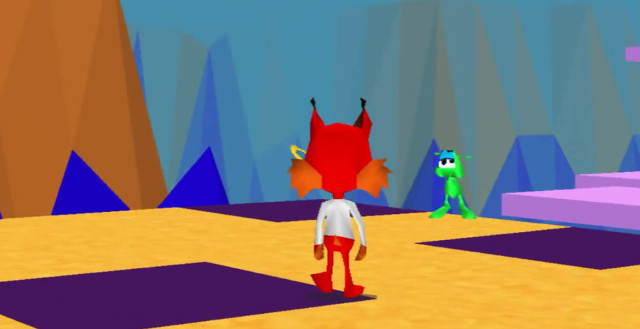
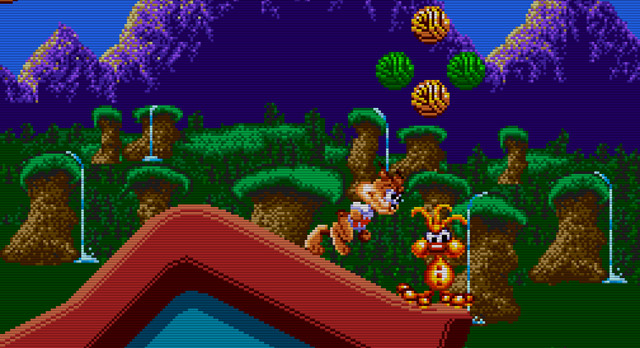
Man, I can’t even begin to imagine what it would have felt like to have Bubsy 3D, not the worst of games mind you, and then to see Mario 64 which would define 3D platforming and gaming going forward. That must have been an definite oh shit moment. Bubsy wasn’t crap, and for a first crack at 3D platforming from an independent styled development team it was a huge success in a space previously uncharted. But Mario 64 just made it seem like all of the rules had been established for years and this level of smooth interactive 3D platforming was no big deal. I still have fond childhood memories of both game though, so I have to thank Berlyn for that. Great article, can’t wait for part two.